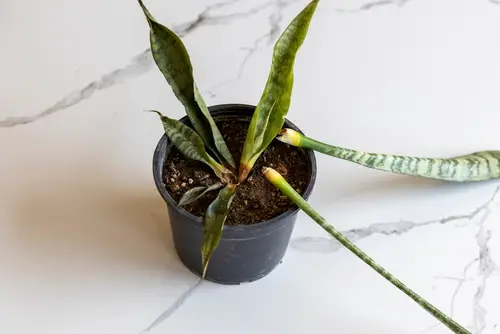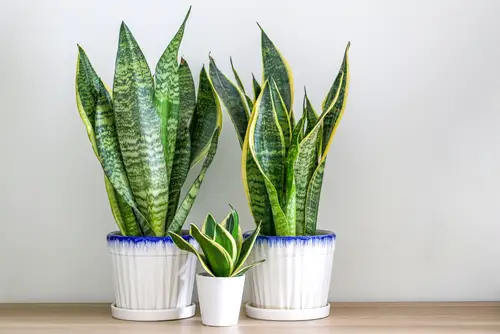Snake plants are a popular choice for indoor gardeners because they are easy to care for and can thrive in a variety of conditions. However, one common problem that snake plant owners may encounter is snake plant getting soft. This can be concerning, as it may indicate that the plant is not healthy and may be at risk of dying.
Understanding snake plants is the first step in figuring out why they may be getting soft. Snake plants are succulents, which means that they are adapted to store water in their leaves and roots.
They are also tolerant of low light and infrequent watering, which makes them a great choice for beginners or those who may not have a green thumb. However, even though snake plants are hardy, they are still susceptible to a variety of issues that can cause them to become soft.
Key Takeaways
- Overwatering is the most common cause of soft snake plants.
- Signs of a soft snake plant include drooping or bending leaves, yellowing or browning leaves, and mushy or rotting roots.
- To fix a soft snake plant, repot it in fresh, well-draining soil, cut off any damaged or diseased leaves, and adjust watering and lighting as needed to prevent future issues.
Similar posts:
- Why Is My Snake Plant Getting Mushy?
- Why Is My Purple Passion Plant Wilting?
- Why Is My Pothos Plant Dripping Water?
Understanding Snake Plants

Snake plants, also known as Sansevieria or mother-in-law’s tongue, are a popular choice for indoor plants due to their ease of care and unique appearance. They are succulent plants, meaning they store water in their leaves, and are native to tropical regions of Africa and Asia.
One of the most distinctive features of snake plants is their long, upright leaves that grow from a central rosette. These leaves are typically green with yellow or white stripes, although there are also solid green varieties. Snake plants are slow-growing and can reach up to 3 feet tall in ideal conditions.
Snake plants are known for their ability to purify the air and remove toxins, making them a popular choice for bedrooms and other indoor spaces. They are also low-maintenance and can tolerate a wide range of growing conditions, including low light and infrequent watering.
However, despite their hardiness, snake plants can still experience issues that lead to soft, mushy, or soggy leaves. In the following sections, we will explore some of the common reasons why snake plants may become soft and how to address these issues.
1. Overwatering
One of the most common causes of soft snake plant leaves is overwatering. Snake plants are succulents and can store water in their leaves, so they do not require frequent watering. In fact, overwatering can lead to root rot, which can cause the leaves to become soft and mushy.
To avoid overwatering, allow the soil to dry out completely between waterings. When you do water your snake plant, make sure to water deeply and allow the excess water to drain away. It is also important to use well-draining soil and a pot with drainage holes to prevent water from accumulating in the soil.
2. Root Rot
Root rot is a fungal disease that can affect snake plants when they are overwatered or planted in poorly draining soil. The disease can cause the roots to become mushy and black, which can lead to soft and mushy leaves.
To prevent root rot, make sure to plant your snake plant in well-draining soil and a pot with drainage holes. Avoid overwatering and make sure to allow the soil to dry out between waterings. If you suspect your snake plant has root rot, it may be necessary to repot the plant in fresh soil and remove any affected roots.
3. Pests
Snake plants are generally resistant to pests, but they can still be affected by spider mites, mealybugs, and other insects. These pests can cause the leaves to become discolored, distorted, and soft.
To prevent pests, inspect your snake plant regularly and remove any affected leaves or insects. You can also use insecticidal soap or neem oil to treat infestations.
4. Lighting
Finally, inadequate lighting can also cause snake plant leaves to become soft and mushy. Snake plants require bright, indirect light to thrive, and they may become weak and floppy if they are not getting enough light.
To ensure your snake plant is getting enough light, place it near a bright window or under grow lights. Avoid placing it in direct sunlight, as this can scorch the leaves.
By understanding the common causes of soft snake plant leaves, you can take steps to prevent and address these issues. With proper care, your snake plant can thrive and add beauty to your indoor space for many years to come.
Why Is My Snake Plant Getting Soft – 5 Common Problems
Snake plants, also known as Sansevieria, are low-maintenance indoor plants that can thrive in a variety of conditions. However, sometimes snake plants can become soft, mushy, or soggy, which can be a sign of an underlying problem. In this section, we will explore the most common causes of soft snake plants and how to fix them.
1. Overwatering and Poor Drainage

One of the most common causes of soft snake plants is overwatering. When snake plants are watered too frequently or the soil does not have adequate drainage, the roots can become waterlogged and start to rot. This can lead to soft, mushy leaves and even cause the plant to die.
To prevent overwatering, allow the soil to dry out completely between waterings and ensure that the pot has drainage holes.
2. Fungal and Bacterial Infections
Fungal and bacterial infections can also cause snake plants to become soft and mushy. These infections are often caused by overwatering or poor drainage, which creates a moist environment that is ideal for the growth of fungi and bacteria.
Symptoms of fungal and bacterial infections include soft, mushy leaves, brown spots, and a foul odor. To treat these infections, remove the affected leaves and improve the plant’s drainage and watering habits.
3. Pest Infestations
Pests such as spider mites, mealybugs, and scale insects can also cause snake plants to become soft and mushy. These pests feed on the plant’s sap, which can weaken the leaves and cause them to become soft and mushy.
To prevent pest infestations, inspect your plant regularly and treat any infestations promptly with insecticidal soap or neem oil.
4. Temperature and Sunlight Issues
Snake plants prefer bright, indirect light and temperatures between 60 and 85 degrees Fahrenheit. Exposure to excessive sunlight, cold temperatures, or sudden temperature changes can cause the leaves to become soft and mushy.
To prevent temperature and sunlight issues, place your snake plant in a location that receives bright, indirect light and maintain a consistent temperature.
5. Nutrient Deficiencies
Nutrient deficiencies can also cause snake plants to become soft and mushy. In particular, a lack of nitrogen can cause the leaves to become yellow and soft. To prevent nutrient deficiencies, fertilize your snake plant regularly with a balanced fertilizer that contains nitrogen, phosphorus, and potassium.
Recognizing the Signs of a Soft Snake Plant
If you notice that your snake plant is getting soft, it is important to take action quickly to prevent further damage. Here are some signs to watch out for:
1. Mushy and Discolored Leaves
One of the most common signs of a soft snake plant is mushy or discolored leaves. If you notice that the leaves of your snake plant are turning yellow or brown, or have black or brown tissue, it could be a sign of overwatering.
Overwatering can cause the roots of the plant to rot, which can lead to soft and mushy leaves. To fix this issue, reduce watering and allow the soil to dry out completely before watering again.
2. Drooping and Lack of Growth

Another sign of a soft snake plant is drooping or lack of growth. If the leaves of your snake plant are drooping or the plant is not growing as it should, it could be a sign of underwatering.
Underwatering can cause the leaves to become soft and limp, and can also lead to stunted growth. To fix this issue, water your snake plant regularly and make sure the soil is moist but not waterlogged.
3. Unpleasant Odors
If you notice a foul odor coming from your snake plant, it could be a sign of root rot. Root rot is a fungal disease that can cause the roots of the plant to rot, leading to soft and mushy leaves.
To fix this issue, remove the plant from its pot and inspect the roots. If you see any signs of rot, cut away the affected roots and repot the plant in fresh soil.
How to Fix a Soft Snake Plant
If your snake plant is getting soft, there are a few things you can do to fix it. Here are some effective methods for fixing a soft snake plant:
1. Repotting and Pruning
One of the most common reasons for a soft snake plant is overwatering, which can lead to root rot. To fix this issue, you may need to repot the plant in fresh soil. Make sure the new soil is well-draining and does not retain too much moisture. You should also remove any damaged or mushy roots during the repotting process.
In addition to repotting, pruning can also help to revive a soft snake plant. Cut off any damaged or mushy leaves, as they can spread disease to healthy leaves. Pruning can also help to encourage new growth.
2. Proper Watering Techniques
Proper watering techniques are crucial for keeping your snake plant healthy. Overwatering can lead to root rot, while underwatering can cause the leaves to wilt and become soft.
To avoid these issues, make sure you water your snake plant only when the soil is dry to the touch. Water deeply and allow the excess water to drain out of the pot.Another way to prevent overwatering is to use a well-draining soil mix. This will allow water to flow freely through the soil, preventing it from becoming waterlogged.
3. Using Antifungal Treatments
If your snake plant is soft due to a fungal infection, you may need to use an antifungal treatment. There are several options available, including hydrogen peroxide, rubbing alcohol, copper-based fungicides, and sulfur-based fungicides.
Be sure to follow the instructions on the label carefully, as some treatments may be harmful to your plant if used incorrectly.
In addition to using antifungal treatments, it’s important to keep your snake plant in a well-ventilated area and avoid overcrowding. This will help to prevent the spread of disease and promote healthy growth.
By following these tips, you can effectively fix a soft snake plant and help it thrive. Remember to monitor your plant closely and make adjustments as needed to ensure it stays healthy.
Preventing Softness in Snake Plants

Snake plants are known for their hardiness and ability to withstand neglect, but even they can become soft and mushy if not properly cared for. Here are some tips to prevent softness in snake plants.
1. Proper Care and Maintenance
One of the most important factors in preventing softness in snake plants is proper care and maintenance. This includes providing the right amount of water, light, and humidity. Snake plants prefer well-draining soil and do not tolerate wet feet. It is important to allow the soil to dry out between watering and to avoid overwatering.
Snake plants also prefer indirect sunlight and can tolerate low light conditions. However, too much direct sunlight can cause the leaves to droop and become soft. It is important to find the right balance of light for your snake plant.
2. Choosing the Right Soil and Pot
Choosing the right soil and pot is also important for preventing softness in snake plants. Snake plants prefer well-draining soil, such as a succulent mix, that allows water to flow through easily. It is important to choose a pot with drainage holes to prevent water from sitting in the bottom of the pot and causing root rot.
Snake plants prefer to be slightly root-bound, so choose a pot that is only slightly larger than the root ball. This will help prevent overwatering and promote healthy growth.
3. Propagation Techniques
Propagation is another way to prevent softness in snake plants. By propagating your snake plant, you can create new plants and prevent the original plant from becoming too large and top-heavy. Propagation can be done by dividing the plant or by rooting leaf cuttings.
To divide the plant, carefully remove it from its pot and separate the root ball into smaller sections. Replant each section in a new pot with fresh soil.
To root leaf cuttings, cut a leaf into several sections and place them in a pot with well-draining soil. Keep the soil moist but not wet and place the pot in a warm, bright location. In a few weeks, new plants will begin to grow from the leaf cuttings.
Frequently Asked Questions
Why are my snake plant leaves soft and wrinkled?
Soft and wrinkled leaves on a snake plant are usually caused by overwatering. When the soil is too moist, it can lead to root rot and mushy leaves.
Other reasons for soft and wrinkled leaves can include low light, pests, or disease. It is important to identify the cause of the problem before taking action to fix it.
How can I save my mushy snake plant?
To save a mushy snake plant, it is important to remove it from the pot and inspect the roots. If the roots are mushy, trim away any damaged parts and repot the plant in fresh soil. It is important to water the plant sparingly after repotting and to ensure that it is getting enough light.
What causes a snake plant to have soggy roots?
Soggy roots on a snake plant are usually caused by overwatering. When the soil is too moist, it can lead to root rot and damage the roots. Other causes of soggy roots can include poor drainage, compacted soil, or a pot that is too large for the plant.
How can I prevent my snake plant from getting soft?
To prevent a snake plant from getting soft, it is important to water it sparingly and to ensure that the soil is well-draining. Snake plants prefer bright, indirect light and should be kept away from drafts and cold temperatures. It is also important to keep the plant clean and free from pests.
What are some common problems with snake plants?
Common problems with snake plants include overwatering, low light, pests, and disease. Overwatering can lead to root rot and mushy leaves, while low light can cause leaves to become thin and spindly.
Pests such as spider mites or mealybugs can also damage the plant, as can diseases such as fungal infections.
How do I propagate a snake plant?
Snake plants can be propagated by dividing the root ball or by taking leaf cuttings. To divide the root ball, carefully remove the plant from its pot and separate the roots into smaller sections. Each section should have a few leaves and a healthy root system.
To take leaf cuttings, simply cut a leaf from the plant and allow it to dry for a few days before planting it in a pot with fresh soil.

Hey, I’m Lisa and I’ve been an avid gardener for over 30 years. I love writing, talking and living in the garden! Feel free to connect with me on my socials below


